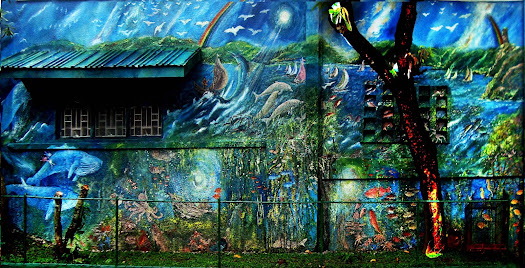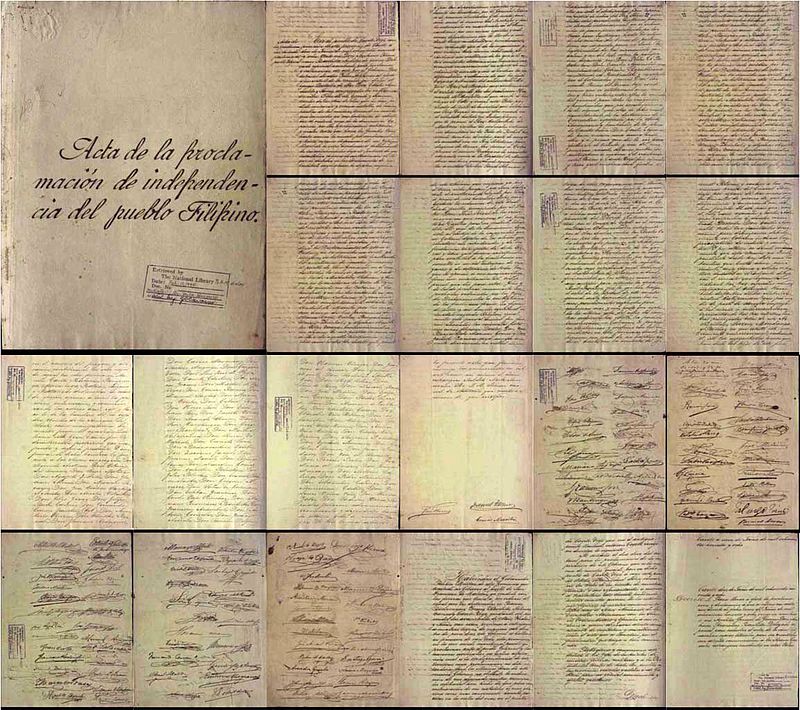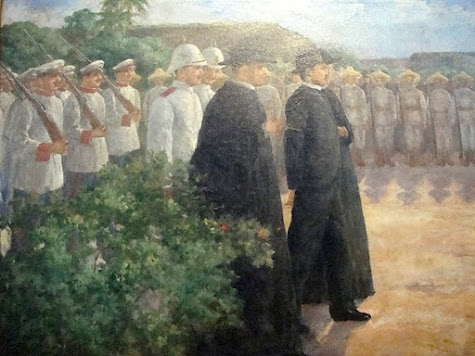Nature comes alive with children
"For most of history, man has had to fight nature to survive; in this century he is beginning to realize that, in order to survive, he must protect it." —Jacques-Yves Cousteau
Mural Paintings and Verses by Dr Abe V Rotor
Living with Nature School on Blog
Never kiss a parrot we are told,
just listen to it talking;
save in circus, among the bold,
on picture, toy and painting.
"If you truly love nature, you will find beauty everywhere."
—Laura Ingalls Wilder

Portion of mural fronting Lam-ang St
Portion of mural fronting Kudyapi St.
The mural consists of representations of ecosystems of the coral reef, mangrove, estuary and the open sea on one side of the wall, while on the other, the ecosystems of the tropical rainforest, stream and river, intertidal zone, mountain and valley.
The mural depicts the unity and interconnectedness of the ecosystems as one holistic Nature with resident species of organisms in their natural state. The presence of man in the mural exudes his playful character, and adventurous nature in exploring the landscape. Some historical and fictional aspects take the viewer to Ernest
Hemingway's prize-winning novel The Old Man and the Sea, and Jules Verne's Twenty Thousand Leagues Under the Sea, while views of Mt Makiling in Laguna and Mt Pulog in Benguet, are typical of many favorite views on the local setting.
The author took six months to complete the mural using as medium acrylic paints conventionally applied with paint brushes. Twelve overhanging LED spotlights were installed to light the mural for evening viewers.
A series of articles about the mural has been published in the barangay newsletter (Greater Lagro Gazette), the Ilocano magazine Bannawag, and on the Internet, Living with Nature [avrotor.blogspot.com]. Christmas with Nature is the mural's theme this Season. Camera enthusiasts and children in the neighborhood frequent the place as a sort of mini park. This article, the fifth of a series, is earnestly dedicated to them.
The author took six months to complete the mural using as medium acrylic paints conventionally applied with paint brushes. Twelve overhanging LED spotlights were installed to light the mural for evening viewers.
A series of articles about the mural has been published in the barangay newsletter (Greater Lagro Gazette), the Ilocano magazine Bannawag, and on the Internet, Living with Nature [avrotor.blogspot.com]. Christmas with Nature is the mural's theme this Season. Camera enthusiasts and children in the neighborhood frequent the place as a sort of mini park. This article, the fifth of a series, is earnestly dedicated to them.

Imagine hugging a tree host of butterflies,
a street post made alive by art's sweet lies,
nature's art of camouflage and mimicry,
tools for survival, sharing and living free.
nature's art of camouflage and mimicry,
tools for survival, sharing and living free.
"There’s a whole world out there, right outside your window.
You’d be a fool to miss it." —Charlotte Eriksson
Sentry the whole night through, an owl retreats
at sunrise into its abode, the hollow of a tree,
and finding a girl playing with butterflies, wonders
if the garden is always open and free.
"Study nature, love nature, stay close to nature. It will never fail you."
—Frank Lloyd Wright
The friendly capybara, the biggest rodent,
never has been tamed, never a pet;
but on a wall, earns love and respect
beyond anime other creatures create.
"Heaven is under our feet as well as over our heads."
— Henry David Thoreau
A twin by the waterfall and stream,
and another twin fishing;
reality and imagery are but one -
parallel worlds we live in.
"Preserve and cherish the pale blue dot, the only home
we’ve ever known." —Carl Sagan
The blue whale, the biggest creature that ever lived,
bigger than the dinosaur, and man a minuscule;
lucky it is to touch, to talk to, to listen to its song,
plaintive with a message for man to heed its call.
Look deep into nature, and then you will understand
everything better. —Albert Einstein
Explore the cave, these kids are challenged,
seeing three of their age emerging;
adventure can never be explained or written;
one must submit to a deep urging.
Touch the rays of the sun through the trees,
be like the butterflies and bees,
the singing birds and the splashing fish,
breath the cool morning breeze.
"Forget not that the earth delights to feel your bare feet
and the winds long to play with your hair." —Khalil Gibran
Do you like to live at the edge of the sea,
where the tides rise and fall and stir,
the waves in rhyme and rhythm with the wind,
where creatures appear and disappear?
Beach party by imagination, hear the music
of the wind and waves, song of the sea gull,
the wall comes alive with echoes of lilting
children, friendship and abandon extol.
"Leave the road, take the trails." —Pythagoras
Can we live under the sea like the fish
among corals and seaweeds?
Only fairies in the world of fantasy do,
yet without the sea all dies,
for the sea provides our basic needs..
It's a kugtong, giant lapu-lapu, and it's true,
dweller at the bottom of the sea,
zealously guarding its cave from anyone;
no fisherman dares, but she,
who is learning to face danger from images
before dealing with reality."There is something infinitely healing in the repeated refrains of nature—the assurance that dawn comes after night, and spring after winter." —Rachel Carson
This is how big a kalaw is, as seen in the wilderness;
its body pitch black, breast bright yellow, beak bright red;
take time, it's now tame on the wall, posing to viewers,
its imagined sonorous call reverberating far and wide.
Splendor on the grass, the world's still,
minute to hour, year to a lifetime;
company of a few, we touch and fill
some vacuum, through nature sublime.
"Choose only one master—nature." —Rembrandt
A bed of grass takes these children
to the field and the meadow;
a waterfall and stream in make-believe
to the ends of the rainbow.~
"Nature does not hurry, yet everything is accomplished." —Lao Tzu

















.jpg)
















.jpg)




















































